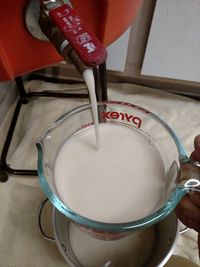Turbid Mash
Turbid Mashing is the traditional mashing process used for the production of lambic. This labor-intensive process involves taking the mash through multiple temperature rests through infusions of hot water and the removal of 'turbid' starchy wort that is not fully converted. The main goals of turbid mashing are to maximize extraction from a grist with a high percentage of unmalted grains and to produce a dextrinous wort in order to feed wild yeasts and bacteria during the long fermentation that beers such as lambic undergo. Turbid mashing also pulls more tannin material from the grain due to especially hot sparge temperatures and prolonged sparging.
Contents
Typical Mash Procedure
Turbid mashing procedures are outlined well in Levi's writeup of Cantillon's procedure and Wild Brews by Jeff Sparrow (see the books page). Turbid mashing requires at least a 4 vessel system (a mash vessel, a vessel to hold turbid portion, a vessel to hold hot infusion water and a boil kettle to receive the mash runnings). An example of turbid mashing based on observing Cantillon's process is as follows:
- The grist, which traditionally in lambic is malted barley and ~30-40% unmalted wheat, is doughed to reach a temperature of 45°C (113°F). At this point the mash is very thick.
- By infusion of hot water the temperature is raised to 56°C (133°F). After a short rest the first turbid portion is pulled. The volume pulled is about 4-5% of the total target brew volume. This turbid portion is then heated to ~ 90°C (~190°F). The main mash rests a bit longer at 56°C.
- By infusion the temperature is raised to 66°C (151°F). This is the main saccharification step and the rest here is longer. The second turbid portion is pulled from the mash during this step (~24% of the total brew volume).
- By infusion the temperature is raised to 72°C (162°F). After a short rest the mash is lautered into the boil kettle.
- After the first runnings are collected, the turbid portion is added back to the mash. This heats the mash to a mash-out temperature. After a short settling time this is also lautered to the boil kettle.
- The mash is sparged with especially hot water (~88°C, ~190°F). This pulls more tannins that a traditional sparging temperature would.
Alternative methods to yield starchy wort
One of the main goals of turbid mashing is to yield a starchy wort in order to carry carbohydrates which are unfermentable to Saccharomyces but fermentable to Brettanomyces and lactic acid bacteria into the fermentation. There are other approaches that brewers have taken to come to this same end result of starchy wort without the labor and equipment-intensive turbid mashing process. These alternatives will likely not yield the same exact results as turbid mashing, but depending on the brewer's goals they may be sufficient and/or preferred. Some of these methods, as outlined in the spontaneous fermentation page, include the addition of flour to the boil [1] passing hot mash runnings through flaked grains [2], soaking a huskless grain such as oats in the boil, pulling mash runnings before full conversion without the prolonged processing of a turbid mash [2][3], or even adding 100% wheat pasta. Although he mostly conducts traditional turbid mashes, James Howat of Black Project Spontaneous Ales has experimented with doing a 165-170°F (74-76.7°C) single infusion of a 60/40% pilsner/raw wheat grist for 15 minutes to simulate extracting the starch content of a turbid mash [4].
See also
MTF Wiki Pages
External Resources
- Levi's writeup of Cantillon's procedure
- Traditional Lambic Using a Turbid Mash - BrewUnited Blog Post
- Lambic.info page on brewing lambic
- Wild Brews by Jeff Sparrow
- American Lambic blog post about traditional v. modern processes
- Early 20th Century Biere de Garde Mashing Technique; by Dave Janssen.
